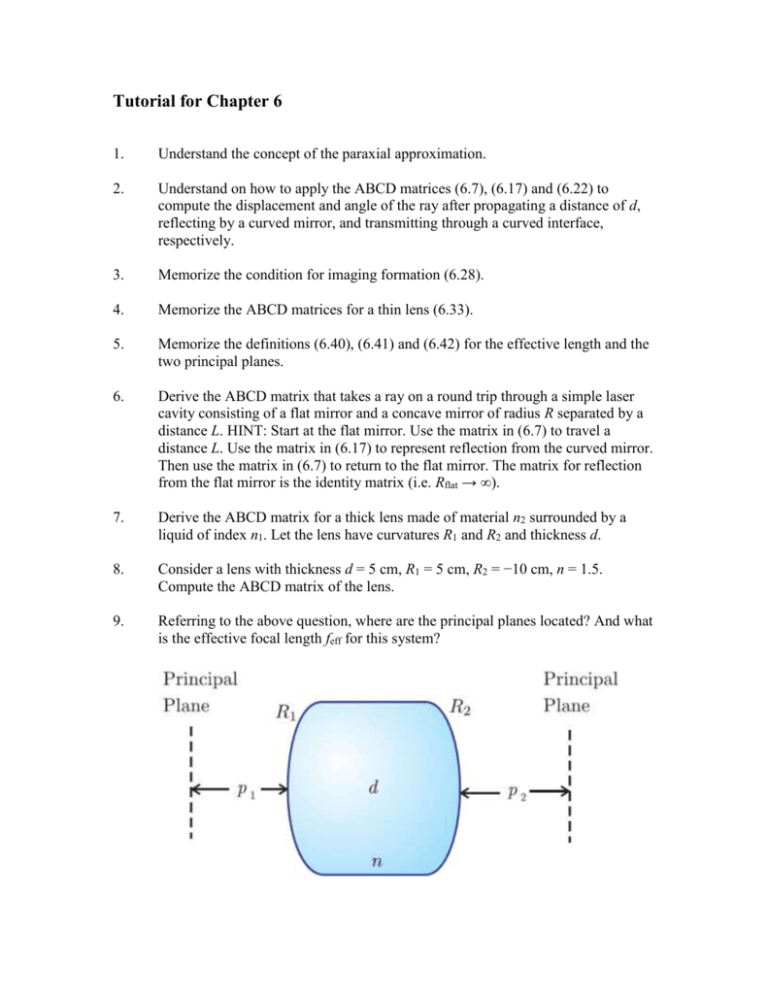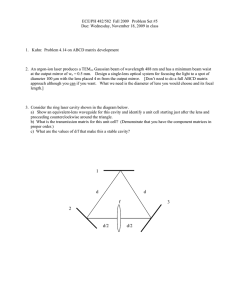Paraxial Optics Tutorial: ABCD Matrices & Lens Systems
advertisement

Tutorial for Chapter 6 1. Understand the concept of the paraxial approximation. 2. Understand on how to apply the ABCD matrices (6.7), (6.17) and (6.22) to compute the displacement and angle of the ray after propagating a distance of d, reflecting by a curved mirror, and transmitting through a curved interface, respectively. 3. Memorize the condition for imaging formation (6.28). 4. Memorize the ABCD matrices for a thin lens (6.33). 5. Memorize the definitions (6.40), (6.41) and (6.42) for the effective length and the two principal planes. 6. Derive the ABCD matrix that takes a ray on a round trip through a simple laser cavity consisting of a flat mirror and a concave mirror of radius R separated by a distance L. HINT: Start at the flat mirror. Use the matrix in (6.7) to travel a distance L. Use the matrix in (6.17) to represent reflection from the curved mirror. Then use the matrix in (6.7) to return to the flat mirror. The matrix for reflection from the flat mirror is the identity matrix (i.e. Rflat → ∞). 7. Derive the ABCD matrix for a thick lens made of material n2 surrounded by a liquid of index n1. Let the lens have curvatures R1 and R2 and thickness d. 8. Consider a lens with thickness d = 5 cm, R1 = 5 cm, R2 = −10 cm, n = 1.5. Compute the ABCD matrix of the lens. 9. Referring to the above question, where are the principal planes located? And what is the effective focal length feff for this system? 9. Show that the ABCD matrix for a thick lens reduces to that of a thin lens (6.33) and (6.34) when the thickness goes to zero. Take the index outside of the lens to be n1 = 1. 10. Find the ABCD matrix for a thick window (thickness d). Take the index outside of the window to be n1 = 1. HINT: A window is a thick lens with infinite radii of curvature. 11. An object is placed in front of a concave mirror. Find the location of the image di and magnification M when do = R, do = R/2, do = R/4, and do = −R/2 (virtual object). 12. A complicated lens element is represented by an ABCD matrix. An object placed a distance d1 before the unknown element causes an image to appear a distance d2 after the unknown element. Suppose that when d1 = a, we find that d2 = 2a. Also, suppose that when d1 = 2a, we find that d2 = 3a/2 with magnification −1/2. What is the ABCD matrix for the unknown element? HINT: Use the conditions for an image (6.37) and (6.38). If the index of refraction is the same before and after, then (6.44) applies. First find linear expressions for A, B, and C in terms of D. Then put the results into (6.44).









